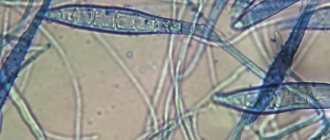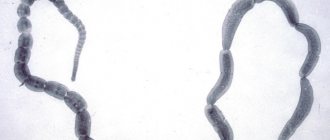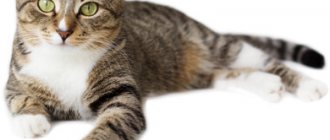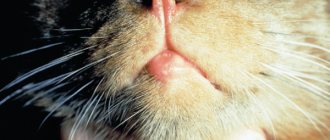Eclampsia (milk fever) is an acute disease of pregnant and lactating cats of a neurological nature, caused by hypocalcemia (decreased calcium levels in the blood), leading to convulsive seizures caused by a disorder of calcium metabolism in the body, called tetany. Tetany (from the Greek tetanos - tension, numbness, convulsion).
Calcium is a mineral that plays a vital role not only in the processes of growth, development and restoration of bone tissue, it is also necessary for the good functioning of the cardiovascular system and for regulating the functioning of the central nervous system. It is calcium that is responsible for transmitting signals to nerve endings. Hypocalcemia causes disruption of the permeability of cell membranes of neurons, which leads to disruptions in the intensity and transmission of nerve impulses, up to blockade of nervous activity and death of the animal.
During pregnancy, the body spends a large amount of labile calcium (calcium circulating in the bloodstream) to build the bodies of the fetuses, and in the last days of pregnancy also to produce milk. If there is not enough calcium circulating in the blood, the mother's body uses stable calcium, i.e. calcium contained in the bones, calcium is washed out of the bones. While feeding kittens with milk, the need for calcium increases sharply. And even if the cat continues to consume calcium in addition to food, it may still not be enough to replenish the cost of milk production. As a result, there is a decrease in calcium levels, a lack of parathyroid hormone and possible eclampsia. Most often, eclampsia develops immediately after birth, but sometimes it occurs a month or more after birth due to leaching of calcium from the cat’s body. The risk factor is the first birth, especially multiple births.
Some cats are inherently predisposed to eclampsia. If your cat is in this risk group or has already had eclampsia after a previous birth, then eclampsia is likely to recur. You should consult with your veterinarian in advance about the dosage of calcium in the diet of a pregnant cat in the second half of her pregnancy.
Many people perceive incipient eclampsia as whims on the part of the cat, and yet delay is extremely dangerous and in the presence of even weak signs it is necessary to urgently begin treatment so as not to lose both the cat and the kittens.
Causes
Knowing the causes of postpartum eclampsia in cats is very important. If we talk about eclampsia in cats, it is worth mentioning that the disease occurs in pets only during the postpartum period. The push effect itself is considered a very powerful nervous disorder, which can be caused by three reasons:
- genetic predisposition - some animals are more prone to eclampsia at the gene level. They may have a weak nervous system, or the code is inherent in natural features;
- metabolism - this factor can depend both on diet and on nervous disorders that can be caused by severe stress;
- factors whose influence comes from the outside - these reasons include difficult or too frequent childbirth. Lack of nutrients, in our case calcium.
Causes of eclampsia
Eclampsia is a critical decrease in serum calcium in the blood to a level of less than 7 mg/dl. Calcium ion deficiency leads to the appearance of tonic and clonic convulsive muscle contractions, as well as changes in neuron membrane potentials. If the pathological process continues for a long time, the cat develops a fever (body temperature rises to 41° C).
The signs of eclampsia are similar to epileptic seizures, but unlike the latter, the deterioration is not temporary (it is long-lasting and increasing), while the animal remains intact and retains sensitivity. The condition is extremely serious, since if medical assistance is not provided, death can occur 12 hours after the onset of the attack (from hyperthermia, due to depressed breathing and brain damage).
A factor for the occurrence of eclampsia is a lack of calcium or an excess of phosphorus, which the cat receives from food and dietary supplements, and metabolic disorders. The root cause may be partial or complete dysfunction of the parathyroid glands that secrete parathyroid hormone (it is responsible for metabolic processes in the body). Other factors that interfere with the absorption of calcium are gastrointestinal inflammatory and infectious diseases, thyroid diseases, increased levels of vitamins A and D in the diet, and renal failure.
With eclampsia, a cat experiences convulsions, but remains conscious (loss of consciousness occurs at the extreme stage of the pathology)
Postpartum eclampsia
Eclampsia in cats in 90% of cases occurs in the postpartum period (most often within 1–2 weeks after the birth of babies, less often after 3–4 weeks). The main reason is poor nutrition during pregnancy. This is accompanied by severe stress during childbirth and general weakness. With milk, the mother gives the kittens the last minerals, causing the condition to become critical. Signs of primary eclampsia are:
- Muscle ataxia (the cat twitches its paws), tremors, convulsions.
- Pale or cyanotic color of mucous membranes and skin.
- The cat’s desire to hide (get away from its kittens), while the animal moves strangely - limps, falls over, and stiffness of movements is noticeable.
- Increased sensitivity; when any part of the body is touched, the cat jerks away and begins to scream.
- Dyspnea (difficulty breathing with an open mouth).
- Periodic vomiting, drooling, uncontrolled urination and bowel movements (diarrhea).
- Severe anxiety, causing rapid heartbeat, tachycardia, shortness of breath.
- The pupils of the eyes are dilated, the light reflex is slow.
When eclampsia is complicated, hyperthermia develops (up to 41° C). The cat may faint or convulse. The extreme condition is coma. After 10–12 hours from the first manifestation of eclampsia symptoms, muscle rigidity is possible, including those responsible for the breathing process and the functioning of the cardiovascular system - if such complications occur, the chances of saving the animal’s life are extremely small.
In the first hour of the development of eclampsia, there may be no obvious symptoms in the cat - the owner should be wary if the animal gets agitated for no reason, abandons its kittens and tries to hide in a dark, secluded place
Eclampsia in pregnant animals
Eclampsia in pregnant cats mainly occurs during multiple pregnancies (when there are five or more kittens in the female’s womb). This is explained simply - the animal’s body spends a large amount of labile calcium (a mineral in the blood) to “build” the body of the cubs, and in the last days of pregnancy a lot of the substance is transferred to the mammary glands in order to feed the babies immediately after birth. If the owner did not feed the cat correctly, did not give it special vitamin and mineral complexes, the calcium contained in the bones begins to wash out, the body stops transferring this substance to stimulate muscle elasticity and nerve conduction - as a result, acute eclampsia develops.
If eclampsia appears in the middle of pregnancy, then there is a high probability of miscarriage or developmental abnormalities in the fetus. Pathology just before the birth of kittens will provoke a complicated birth - the fact is that calcium is directly involved in muscle contraction. If it is deficient, uterine inertia occurs (labor becomes impossible due to the lack of contractions), and a caesarean section will most likely be required.
Risk group
Cats of different ages and genders can be susceptible to the disease.
Animals at risk include:
- primiparous;
- with multiple pregnancy;
- having calcium deficiency during previous births;
- those receiving an unbalanced diet or medications that reduce calcium levels in the blood;
- aged.
Which cats are at risk?
Pathology can be observed in both outbred and purebred cats. First of all, the development of eclampsia is influenced by external factors (poor nutrition, multiple pregnancy). But there is a predisposition to calcium deficiency. For example, if a cat developed this pathology during her previous pregnancy, then most likely the situation will repeat itself when carrying kittens again.
A cat carrying or nursing more than 5 kittens is at particular risk of developing eclampsia
Cats with the parathyroid glands removed, those exposed to radioactive substances, or survivors of severe chemical poisoning are at risk of eclampsia. According to statistics, cats that become pregnant over the age of 6 years are susceptible to intense calcium leaching, which is explained by an age-related slowdown in metabolic processes.
Often, a violation of the absorption of minerals occurs as a complication after poisoning - as a result of the activity of toxins that bind to calcium molecules and prevent the body from absorbing them
Symptoms
Like many other diseases, eclampsia is accompanied by a number of symptoms, knowledge of which can greatly make life easier for both the pet and the owner. Understanding the symptoms of a particular disease, the owner has the opportunity to quickly respond and seek help from a veterinarian. It is important to understand that the owner’s task is not to identify the disease, but to quickly react to its manifestation.
- inappropriate behavior of the animal - the cat may seem confused, as if it does not understand what is happening around;
- mood swings - if a moment ago the cat was the sweetest and benevolent creature, then after a couple of minutes this can be replaced by sudden aggression and a fit of rage;
- mastitis – may appear during eclampsia;
- temperature change - the thermometer readings do not increase, but rather become lower. This is one of the signs of the disease;
- coordination - the animal may walk staggering. There is no need to confuse weakness in the limbs and lack of coordination, these are different symptoms;
- pupils – as a rule, they are slightly dilated;
- convulsions - can be observed in different limbs.
Diagnostics
Before prescribing proper treatment, it is necessary to diagnose the body. The fact is that the symptoms that a cat exhibits with eclampsia are very similar to ordinary nervous disorders. And if sometimes an inexperienced specialist can make a mistake in making a diagnosis, there can be no talk of any self-diagnosis methods by untrained people. Our veterinary center offers the services of only highly qualified specialists who know a lot about their business and bear full responsibility for their actions.
It is impossible to say exactly what examinations a doctor may prescribe when detecting eclampsia in cats. But we can say for sure that taking blood tests will be almost necessary . Since this is a basic set of tests that allows you to see the general condition of the body and individual organs.
Symptoms of the disease
With any disease, the animal's behavior changes. If a cat is sick, it can be recognized and the animal can be helped. Many animals experience diseases differently. Some cats may experience shortness of breath, unnatural bending, or hatred towards their own offspring. She may begin to be capricious, which at first will not cause concern, but it is important to take all changes into account.
Main symptoms:
- increased breathing;
- strong excitement;
- high jumping;
- sharpness or sluggishness in movements;
- defeat by convulsions;
- fear of people;
- strong tension of the skin on the muzzle, the mouth is slightly open;
- the cat bites kittens, carries them in her teeth;
- you can observe the animal walking on its hind legs, which is caused by muscle spasms;
- at an advanced stage, the animal falls on its side, shaking its paws, saliva is released profusely, it does not react to external circumstances, but is conscious.
Often the symptoms of the disease are not detected immediately. When a cat’s temperature rises to 41°C and her breathing quickens, immediate action must be taken, otherwise she may die from hyperthermia within 12 hours.
If several of the above symptoms are detected, you should immediately contact your veterinarian. He will be able to diagnose the exact disease and prescribe treatment in accordance with the general condition of the animal and the results of the tests performed.
Basic information about the disease
Diagnostic methods include a general examination of animals, taking medical history data, conducting serological and laboratory tests. With eclampsia in cats, changes in pH levels and a decrease in the concentration of calcium in the bloodstream (hypoglycemia) are noted. After diagnosis, cats with eclampsia are prescribed complex therapeutic, etiotropic therapy, which involves intramuscular, intravenous administration of calcium gluconate. In the acute stage - magnesium sulfate. As maintenance therapy, veterinary specialists administer nutritional drips, administration of glucose solution, prednisone, cardiac glycosides, and sedatives (Diazepam). Treatment of eclampsia with corticosteroids requires caution and strict dosage, as they reduce the absorption of calcium in the body.
Animals are prescribed a therapeutic diet rich in calcium, phosphorus, magnesium, a diet, and mineral and vitamin complexes are prescribed. The dosage of calcium, minerals and vitamins is prescribed on an individual basis. Cat owners must provide their animals with complete rest and proper care. Your pet should be protected from stress and any irritating factors.
Kittens are transferred to artificial feeding until the symptoms of the disease in the mother cat completely disappear and her physical condition normalizes. In especially severe cases, animals are transferred to inpatient treatment (hospitalization) in a veterinary hospital.
During acute attacks, you should not treat your cat yourself. You urgently need to call a veterinarian!
With timely diagnosis and timely, effective, correct treatment, the prognosis is favorable. Symptoms of eclampsia in cats go away within 5-8 days.
Treatment with calcium gluconate
Impaired calcium absorption and autointoxication of the body due to the accumulation of postpartum secretions in the uterus lead to a disease such as eclampsia in cats. Treatment at home should be etiotropic, that is, eliminating the cause. The main drug for replenishing the deficiency of the missing microelement is calcium gluconate. After consulting a veterinarian, the medicine can be administered intramuscularly at home.
The dose of calcium gluconate should be determined by the doctor, but on average, to relieve an attack of eclampsia, intramuscular administration of 1 ml of a 10% solution is recommended at intervals of 40 minutes until the characteristic symptoms cease.
To eliminate swelling, the animal can additionally be prescribed Prednisolone, and to eliminate muscle spasms, Drotaverine (No-Shpa). After acute symptoms are relieved, the cat is usually administered intramuscular calcium gluconate twice - morning and evening - 1 ml for 7-10 days.
Treatment
If the diagnosis is confirmed by a doctor, treatment should begin. Therapeutic measures should begin immediately. Because the slightest delay in providing veterinary care can result in death for your pet.
Treatment methods do not have a wide range and are limited to saturating the animal’s body with calcium. But not everything is as simple as it might seem at first glance . The dosage of the drugs used, no matter what form they are in, tablets or injections, should be determined only by a veterinarian. A lack of calcium can result in an excess, which is not good for your pet. There is no need to look for extremes, you need normal levels of the substance in the body.
The treatment itself most often takes the form of injections to the cat. A solution containing calcium is administered intravenously to a sick cat. Some veterinarians advise using calcium intended for human consumption, this is due to the insufficient absorption of the veterinary product. In order for the solution to be better accepted by the body, it should be heated to the desired temperature - this is slightly above room temperature.
Causes:
- Incorrect diet, poor in calcium and/or rich in phosphorus.
! The disease is typical for animals that eat only meat.
Meat is very rich in phosphorus, but contains little calcium. There is also a lot of phosphorus in fish. Most meat diets have a Ca:P ratio of 1:25 or higher. For example, in horse meat the Ca:P ratio is 1:10, in the heart and liver it is 1:50
| Name | Beef | Veal | Mutton |
| Calcium (g/kg) | 0,15 | 0,22 | 0,24 |
| Phosphorus (g/kg) | 12,10 | 12,00 | 11,45 |
- Breed predisposition. Cats have individual abilities to absorb and retain calcium. The most susceptible to the disease are Siamese, Scottish and British breeds, and Sphynxes.
- Poor absorption of calcium is also promoted by: gastrointestinal diseases, thyroid diseases, kidney failure, increased amounts of vitamins A and D, fluorine, magnesium and phytin in food.
- Growth rate. Fast growing animals are more sensitive to calcium deficiency.
Eclampsia in cats after birth: first aid at home
Before the veterinarian arrives, you can provide your cat with assistance that will alleviate its condition or prevent complications of eclampsia in cats after birth. But first aid should not be confused with self-medication . Only a doctor should treat an animal. Otherwise, you will only cause him harm, which can lead to death. Below are basic guidelines for providing first aid to a cat :
- isolation of the animal from its offspring - to avoid harm;
- rest – the animal should be at rest and avoid stressful situations;
- atmosphere - in the room where the isolated pet is located there should be dim light and clean air.
- to avoid the consequences of seizures - to do this, you need to cover the animal on all sides with soft blankets or pillows.
Causes and mechanism of development of the disease
During pregnancy, natural changes occur in which calcium from the mother’s body is spent on the formation of the kittens’ skeleton in the womb. Parathyroid hormone is responsible for the absorption and entry of this element into the bones and muscles (it is produced by the parathyroid gland).
Sometimes at the end of pregnancy or after childbirth, the mentioned gland cannot be rebuilt and provide the cat’s increased needs for calcium. As a result, only milk is saturated with it, but not the animal’s body. These processes explain the mechanism of the pathology, and their study allows us to understand how eclampsia develops in cats after birth. Treatment of the disease involves rest and saturation of the body with calcium.
The development of eclampsia is facilitated by poor nutrition and diseases of the digestive system, which impair calcium absorption. Most often, this pathology is diagnosed in primiparous animals. Cats who have given birth to many kittens are prone to it, as their calcium needs are even higher.
This is interesting: Symptoms and treatment of pneumonia in cats
In what situations can a disease not be treated at home?
Eclampsia is a disease that, if not properly treated, can lead to the death of an animal. A cat can die due to high body temperature (above 41 °C) or due to brain damage and depression of the respiratory center.
There are signs of eclampsia in cats, which indicate a severe course of the disease and the need for hospital treatment. If after the start of therapy there is no improvement in the animal’s condition for a couple of hours, this may indicate the need for intravenous infusion of the drug.
In cases of prolonged increase in body temperature, which is not brought down by medication and home methods, it is also recommended to hospitalize the cat. This must be done to avoid destruction of protein structures and the development of severe seizures. In the hospital, it is possible to administer medications under ECG monitoring, which makes it possible to recognize cardiac disorders in time and begin to fight them.
Symptoms and course of the disease
It’s worth clarifying right away that calcium deficiency occurs in cats of different ages and breeds, so the symptoms in all sick animals will be similar.
Symptoms:
- Increase in body temperature to 41°C.
- Rapid breathing.
- Disturbances in heart rhythm.
- Pallor of the mucous membranes.
- Refusal to consume food.
- Restless or lethargic state.
- The cat begins to bite the kittens or leaves them.
- The animal completely loses its memory or ceases to recognize its owner.
- Convulsions of varying strength and duration occur.
- Loss of coordination.
Check out the common ones
diseases of cats
, as well as methods of their treatment.
READ Which ointment to treat ringworm in cats? Universal ointment for lichen in cats
We wrote above that a lack of calcium affects the neural communication between the central nervous system and muscles. So, the disease manifests itself in the form of attacks, which are preceded by a nervous state of the animal. The cat begins to be afraid of everything and cannot sit in one place.
Immediately before the attack, the limbs begin to tremble, after which the animal loses coordination and falls, taking an unnatural position. A spasm of the limbs occurs, breathing becomes heavy, and the tongue falls out.
Important! With any contact with an animal during an attack, convulsions intensify, and the general condition worsens.
Between repeated attacks, several hours or several days may pass, but each time the attacks will become stronger and more painful.
A kitten aged from several weeks to several months suddenly develops a feeling of discomfort and pain. He begins to play sluggishly and reluctantly, preferring to just sit or lie down. Sometimes the kitten hisses or even bites, not allowing itself to be touched.
The most striking sign of the disease, lameness, occurs as a result of musculoskeletal pain. The kitten's bones become soft and bendable. With excessive activity, which is typical for kittens, this leads to multiple fractures (like a “willow branch”) and microfractures.
Moreover, not only the bones of the limbs bend, but also the vertebrae. The result is neurological disorders, such as paresis and paralysis of the limbs, incontinence or, conversely, retention of urine and stool.
Weakness of the bones often leads to curvature of the paws, deformation of the chest and pelvic bones is possible, as well as impaired growth and replacement of teeth.
Prevention of eclampsia in cats
Better than any treatment is the absence of disease. Preventive measures will help prevent the onset of illness in your pet. They consist of certain actions aimed at improving the health of the animal and its conditions of detention. All recommendations are created by leading veterinarians. In the case of eclampsia, strong attention needs to be paid to the cat during pregnancy. Below are some of them:
- nutrition - when an animal carries offspring in its tummy, it should be remembered that it shares all the nutrients it receives with the future kittens. That is why it is necessary to fully saturate the body with all the necessary microelements;
- emotional state – during pregnancy you should avoid various stresses that can have a detrimental effect on both the health of the fetus and the health of the cat itself;
- Other diseases - diseases suffered by animals during pregnancy will in any case leave a mark on the general condition.
Prevention
The main role in preventing such a dangerous phenomenon as eclampsia in cats is played by a complete, balanced diet during pregnancy. It should not only have calcium deficiency, but also its excess. The intake of high doses of this element from food into the body during pregnancy can lead to malfunctions of the parathyroid gland and become an indirect cause of the development of metabolic disorders in the future.
If an animal has already been diagnosed with eclampsia during a previous birth, then you should try to maximize the interval until the next pregnancy. In this case, you should approach nutrition issues with particular care and be sure to undergo veterinary examinations on time.
Characteristic clinical signs
The symptoms of the disease are pronounced, so it is almost impossible to miss the signs of eclampsia.
These include:
- Refusal to feed and increased salivation.
- Increased temperature and irregular heart rhythm.
- Frequent breathing and depression.
- Paleness of the conjunctiva and mucous membranes.
- Behavioral disturbance - the animal begins to worry or, on the contrary, behaves inhibited. Concern for the kittens increases, the cat hides them or moves them from one place to another. The mother can also abandon her offspring.
Severe symptoms include:
- loss of consciousness;
- presence of seizures;
- numbness of some parts of the body;
- loss of coordination.
All these signs of milk fever are increasing. And you need to be able to notice them in time and take the necessary measures.
Treatment options
Ignoring the symptoms of the disease can threaten the animal's life. The main treatment is aimed at replenishing calcium levels in the pet’s body. Since she has virtually no appetite in this state, you should not try to give calcium to your cat through food. In addition, the necessary component in the tablets at this stage will no longer be effective.
IMPORTANT! The main treatment is aimed at administering drugs by injection, and you need to know exactly how to inject the medicine into a cat correctly. It is advisable to leave the animal at the veterinary clinic for the period of treatment.
Basic therapy includes:
- Intramuscular injection of 10% calcium gluconate. In this case, the medicine is preheated to 40°C and diluted with saline solution. The drug is aimed at reducing pain and preventing necrosis. The drug is administered once over 40-50 minutes until the symptoms disappear. It is important to calculate the daily dose; it should not exceed 10 ml.
- During an exacerbation, treatment is supplemented with subcutaneous administration of magnesium sulfate. It is not advisable to give two different injections in the same paw.
- Since postpartum eclampsia is accompanied by a decrease in the concentration of sugar in the blood, to strengthen the body weakened by the disease, a glucose solution is administered to the cat. Medicines are also prescribed that stabilize the heart.
- To consolidate the therapeutic effect, calcium gluconate must be administered for several more days (from 2 to 7), which will help reduce the frequency of attacks.
- The disease can also be treated using homeopathy or herbal remedies.
It is advisable to carry out therapeutic therapy for eclampsia in a cat under the supervision of a veterinarian. The animal must be tested every week to monitor calcium levels in the blood. Treatment can only be completed with the permission of a veterinarian.
If treatment takes place at home, the cat is temporarily placed in a dark and quiet room, and the kittens are also isolated for a while. If therapeutic measures are started in a timely manner, then after just a few injections of drugs the disease goes away.
Prognosis and prevention
If you seek help from a specialist early, the prognosis for the outcome of the disease is favorable. It will be enough just to observe the animal, feed it according to the schedule and add calcium to the food.
With timely assistance to a cat with eclampsia, the prognosis is favorable.
In severe cases, the cat will require long-term treatment with heart medications and vitamin complexes.
If you consult a doctor in a timely manner and start therapy, the prognosis is favorable. In advanced cases, as well as when cardiac activity weakens or a caesarean section is necessary, the attack can be fatal. To avoid hypocalcemia in cats, it is recommended to consult a doctor before mating and undergo a health examination and blood calcium level.
Also, an examination by a specialist is necessary during pregnancy, and childbirth, especially the first one, is best done in the presence of a doctor. At all stages of animal development, food should be selected of high quality, enriched with essential vitamins and microelements. The interval between previous and subsequent births must be at least 1 year.
Postpartum eclampsia in cats whose treatment is started in a timely manner has a very favorable prognosis. Just a few injections of the drug, and the cat will not even remember the disease. However, just a few days without treatment, and the animal will no longer need help at all.
It is for this reason that it is necessary to pay maximum attention to the cat who has given birth, noticing any, even minor, deviations from her usual behavior.
How is the treatment carried out?
Typically, eclampsia requires immediate emergency treatment. The body is in a hopeless situation: it requires calcium, but its reserves have depleted, and there is no longer an opportunity to get it with food. With this disease, the cat loses its appetite and digestion is disrupted, so adding calcium supplements to the food is pointless. The only way out is to treat the animal by injecting calcium supplements into the blood.
READ How to determine if a cat has worms
The recovery process and the treatment regimen itself depend on the moment at which the animal owner seeks help from a specialist. Treatment at home can lead to the death of the cat, since in most cases emergency administration of calcium supplements is necessary. Otherwise, the pet may die from heart failure.
In late pregnancy, the cat will have a caesarean section and will be given calcium supplements for the next 7-10 days. If eclampsia is diagnosed in a nursing cat, it will require temporary isolation from the kittens. This is required so that the animal can recover in complete peace. At this time, kittens are fed artificially.
Diagnosis of hyperparateriosis
When diagnosing this disease, an X-RAY is indicative, since in blood tests the level of calcium and phosphorus usually turns out to be normal (except for severe cases), in the urine - calcium is slightly reduced.[/fusion_text][/fusion_builder_column][/fusion_builder_row][/fusion_builder_container][ fusion_builder_container hundred_percent=”yes” overflow=”visible”][fusion_builder_row][fusion_builder_column type=”1_1" layout=”1_1" background_position=”left top” background_color=”” border_size=”” border_color=”” border_style=”solid” spacing=”yes” background_image=”” background_repeat=”no-repeat” padding=”” margin_top=”0px” margin_bottom=”0px” class=”” id=”” animation_type=”” animation_speed=”0.3" animation_direction=” left" hide_on_mobile="no" center_content="no" min_height="none" last="no" hover_type="none" link="" border_position="all"][fusio[fusion_text]p>Pathological fracture. The density of the bone is fused with soft tissues
But on an x-ray, a decrease in bone tissue density will be noticeable, the bones look transparent, their walls are thinned, the contrast between the bones and soft tissues is very weak, and pathological or already healed fractures that were not previously noticed may also be visible.
The images can be used to assess bone deformation. To predict the development of the disease, you should look at pictures of the pelvis and chest.
In cats with neurological disorders, the condition of the spine is assessed. In severe cases, x-rays will show deformation of the vertebrae, curvature of the spine, and a full bladder and intestines. These animals need urgent help!











